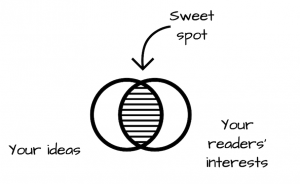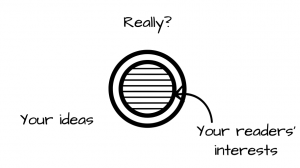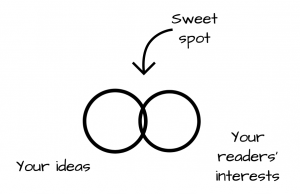Finding the Sweet Spot for your Next Nonfiction Writing Project
As a thought exercise, take a current writing project you have in front of you – whether that’s a blog post, an article, a book, a memo. It could be nearly anything.
Make a list of all the things you want to get across in this piece of writing:
- What do you want to write about?
- What stories, data, or ideas do you want or need to share?
- What’s important to you to communicate?
Now, make another list. Given the reader you’re trying to reach:
- What are they looking for when they find your writing?
- What do they enjoy reading or find valuable?
- What might interest them or catch their attention?
If you could chart them into a Venn Diagram – where’s the overlap? That’s your sweet spot.

The common ground between your interests and your readers is your starting point.
Maybe you think that everyone is interested in everything you have to say. If that’s the case – well, congratulations. You must have a fascinating topic or an exceedingly narrow audience.
Or, perhaps, you’re mistaken about that amount of overlap.

The list of people who share your exact enthusiasms may be smaller than you imagine. In reality, many people only care about a subset of your idea subject – the bits that apply to them.
A more realistic Venn diagram might look like this:

That’s good to know ahead of time.
What to do with this information
You have a few options:
- Restrict yourself to writing about the small part that meets the readers’ known needs. It may not be rewarding or fulfilling, but you’ll probably find an audience.
- Go ahead and write what you want to write, without regard for the readers. Of course, you risk obscurity, but it might feel good.
- Start with the overlap and then entice readers to become curious about the subject and share your enthusiasm. Earn their attention and expand that sweet spot.
The last one is much tougher to do, but can be a lot of fun. That’s where the skill, creativity, and craft of nonfiction writing comes into play.
Just make sure you know where to start.
Further Reading
This blog is based on my newly released book, Writing to Be Understood: What Works and Why.
